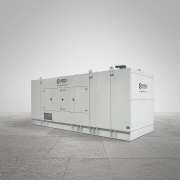Advances in Remote Monitoring and Telemetry for Power Generators

The digitalisation of energy systems has revolutionised the power generator sector. In this context, advances in remote monitoring and telemetry for power generators are redefining the way these units are managed, monitored and optimised. The ability to start a generator remotely, monitor its status in real time and anticipate faults adds a level of efficiency, safety and reliability that was unthinkable just a decade ago.
How Does Remote Start Work in a Generator?
Knowing how to start a generator remotely is no longer the preserve of specialist technicians. Today, thanks to connectivity and automation technologies, any authorised user can start a generator from a mobile phone, tablet or computer – safely and securely.
Remote starting is carried out via control systems connected through mobile networks or Ethernet. These platforms allow the generator to be activated without being physically present, which is particularly useful in remote locations, emergency backup systems, or sectors such as industry, healthcare and telecommunications.
Benefits of Remote Monitoring in Generator Management
Equipping a generator with a remote monitoring system brings numerous advantages:
- 24/7 supervision: real-time information on operational status, fuel levels, temperature, oil pressure, and more.
- Instant response: the system sends immediate alerts in the event of a fault, enabling rapid intervention.
- Maintenance optimisation: collected data supports the scheduling of preventive maintenance tasks, reducing unexpected shutdowns and extending the equipment’s service life.
- Cost reduction: fewer breakdowns and unnecessary site visits translate into optimised technical and financial resources.
Moreover, these systems are scalable and adaptable to any generator model, from portable units to large-scale industrial solutions.

Key Telemetry Technologies for Power Generators
Telemetry in power generators relies on sensors, controllers and communication modules that collect and transmit data to cloud platforms. Key technologies include:
- PLCs and intelligent controllers: for collecting generator operational data.
- Communication modules (GSM, 4G, LTE, Ethernet, Wi-Fi): which transmit data to control centres or mobile applications.
- SCADA systems and IoT platforms: for visualising data, generating reports, and controlling equipment remotely, reducing the need for human intervention.
- Cybersecurity protocols: with encrypted communication and advanced authentication to safeguard remote system access.
These technologies are custom-integrated based on the generator type, power output, intended use, system integration and environmental conditions.
Applications of Remote Monitoring Across Sectors
Remote monitoring and remote start systems for power generators are now used across many sectors:
- Data centres: where uninterrupted power is critical and continuous monitoring is essential.
- Hospitals: where emergency generators must always be available with no margin for error.
- Construction and infrastructure projects: in areas without stable grid access.
- Telecommunications: in repeater towers and remote stations where access is difficult and power surveillance is vital.
- Agriculture and livestock farming: to run irrigation, ventilation or refrigeration systems in rural areas.
In all these sectors, the ability to start a generator remotely is a strategic solution to unexpected power issues.

Impact on Efficiency and Maintenance of Generators
Remote monitoring has transformed the concept of operational efficiency. Thanks to telemetry, it is now possible to:
- Reduce downtime.
- Detect faults before they occur.
- Improve the planning of technical resources.
- Avoid unnecessary technician site visits.
In addition, the continuous collection of data enables predictive maintenance models, where systems “learn” from previous patterns to recommend specific interventions.
Advances in remote monitoring and telemetry for power generators are redefining the way these units are managed, monitored and optimised.
This approach not only improves the overall performance of the power generator but also enhances the reliability of the energy system as a whole.
Safety and Control in Remote Operation
One of the most valued aspects of remote start systems is security. To protect generator operation and prevent unauthorised access, various measures are implemented:
- User profiles with differentiated permissions.
- Access control using two-factor authentication.
- Encrypted data transmission systems.
- Operation logs for audits and traceability.
Furthermore, in the event of a fault or tampering attempt, the system can automatically block access and notify technical staff.
Trends and the Future of Smart Monitoring in Generators
The future of smart generator monitoring lies in even deeper integration with emerging technologies such as artificial intelligence and machine learning. These tools will enable:
- The analysis of large volumes of operational data.
- The early detection of anomalies, even before they become noticeable.
- Greater automation of real-time energy management.
Likewise, the adoption of generators compatible with HVO (Hydrotreated Vegetable Oil) and other clean energy sources will require more advanced monitoring platforms that track not only performance but also the environmental impact of each operation.

Conclusion
The implementation of remote monitoring and telemetry is raising the bar for reliability, efficiency and control in the power generation sector. Being able to start a generator from anywhere, anticipate faults, and manage maintenance efficiently makes these systems essential allies in the transition towards a smarter, more resilient energy model.

























